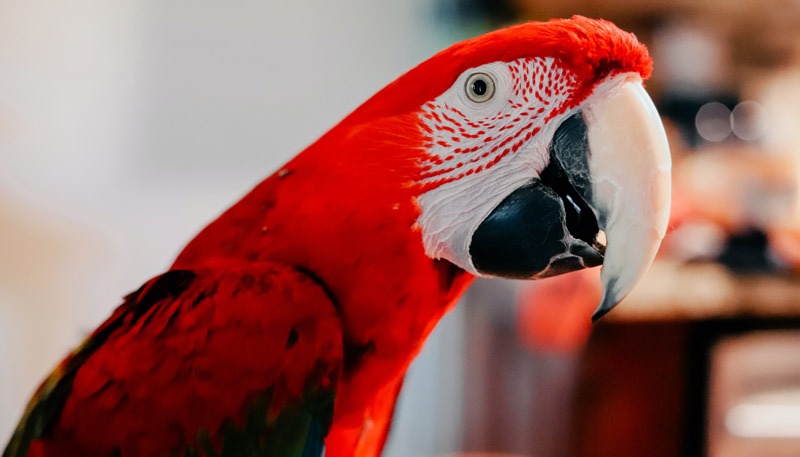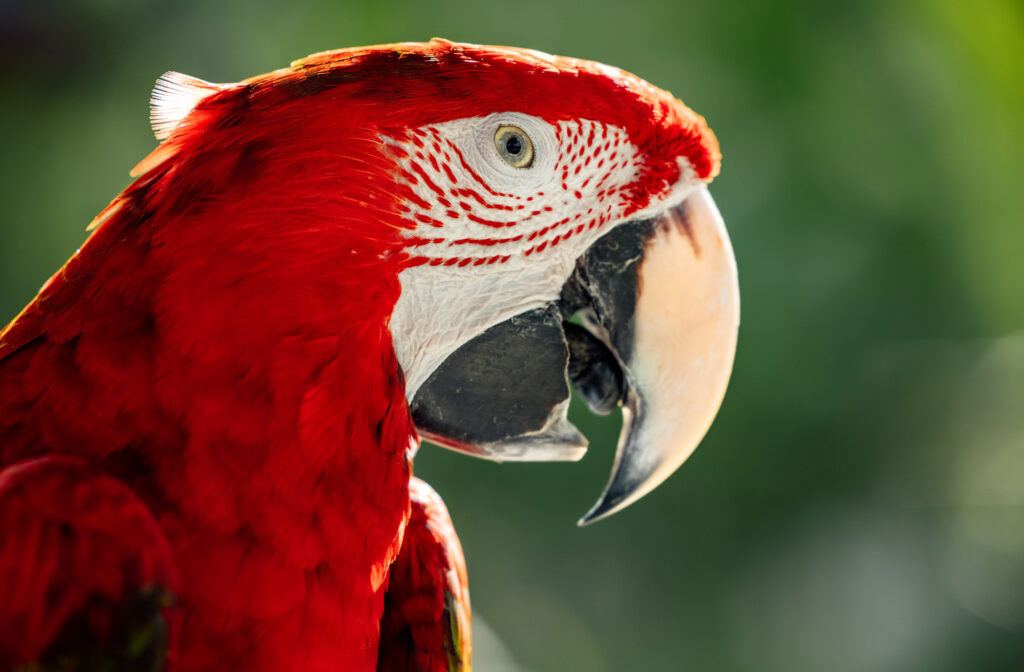SCARLET MACAW, RED PARROT, RED BIRDS, LIFESPAN, CENTRAL AND SOUTH AMERICA, AMERICAN PARROTS, DIET, SOUNDS
The Scarlet Macaw ( Ara macao), also known as the red-and-yellow macaw, is a colorful and charismatic bird that is found in Central and South America. With their bright plumage and loud calls, these birds have captivated humans for centuries and have played an important role in the cultures and traditions of the region. However, the Scarlet Macaw is also facing several threats, including habitat loss, hunting, and the pet trade. In this essay, we will explore the natural history, conservation status, and threats facing the Scarlet Macaw, as well as the efforts being made to protect and conserve this important species.
SIZE AND WEIGHT OF THE SCARLET MACAW
To begin with, the Scarlet Macaw is one of the largest macaw species, with a length of 81-96 cm (32-38 in) and a wingspan of up to 120 cm (47 in). It can weigh up to 2.2 pounds (1 kg). The male and female Scarlet Macaw are generally similar in size, with the male being slightly larger on average. They are known for their bright red, yellow, and blue plumage, with a white face and black beak. Scarlet Macaws are found in a variety of habitats, including rainforests, savannas, and swamps, and can be found from southern Mexico to the Amazon Basin in South America. They are highly social birds and are often found in large flocks, with individuals communicating through a variety of loud calls.
DIET OF SCARLET MACAWS
Scarlet Macaws are omnivores, feeding on a variety of fruits, nuts, seeds, and insects. They play an important role in their ecosystems by dispersing the seeds of the plants they feed on and providing food for predators such as snakes and large birds of prey. They are also important cultural and spiritual symbols in many Indigenous communities throughout the region, where they are revered for their beauty and intelligence.
In captivity, Scarlet Macaws are often fed a diet of fresh fruits and vegetables, supplemented with nuts and seeds. It is important to provide them with a varied diet that is like what they would eat in the wild, as a lack of variety can lead to health problems. In some cases, captive Scarlet Macaws may also be fed specialized pelleted diets that provide all the necessary nutrients they need to stay healthy.
Overall, Scarlet Macaws are opportunistic feeders that will consume a wide range of plant and animal matter, and their diet can vary depending on the availability of food in their environment.

LIFESPAN OF SCARLET MACAW?
To pursue, it has a relatively long lifespan compared to many other bird species, with individuals typically living for up to 40-50 years in the wild. In captivity, some individuals have been known to live even longer, with some reaching ages of over 75 years old. The lifespan of a Scarlet Macaw can be influenced by several factors, including habitat quality, availability of food and water, predation, disease, and human impact on the environment. With proper care and protection, these birds can live long and healthy lives in the wild and in captivity.
CONSERVATION STATUS
The Scarlet Macaw is listed as a species of Least Concern by the International Union for Conservation of Nature (IUCN). However, this status is misleading, as the species has declined dramatically in many areas of its range due to habitat loss, hunting, and the pet trade. The species is considered endangered in some countries, including Costa Rica, El Salvador, and Mexico.
THREATS TO SCARLET MACAW
Habitat loss is one of the major threats facing the Scarlet Macaw. In fact, deforestation and land conversion for agriculture and other uses have led to the loss of much of the bird’s natural habitat. In addition, illegal logging, mining, and road construction have further fragmented and degraded the remaining habitat, making it more difficult for the birds to find suitable nesting and feeding sites.
PET TRADE OF RED PARROTS
In addition, hunting and the pet trade are significant threats to the Scarlet Macaw. The birds are highly prized for their bright plumage and are illegally captured and sold as pets or for their feathers. This trade not only harms individual birds but can also have a significant impact on the population, as it reduces the number of breeding pairs and the genetic diversity of the population.
CONSERVATION EFFORTS
Efforts are underway to protect and conserve the Scarlet Macaw and its habitat. Many organizations and governments are working to establish protected areas and wildlife reserves, which can provide a safe space for the bird to live and breed. In addition, conservationists are working with local communities to promote sustainable land use practices that can reduce the impact of human activity on the bird’s habitat.
Education and awareness programs are also important for protecting the Scarlet Macaw. By increasing public knowledge and awareness of the bird’s importance and threats, conservationists can help to mobilize support for protection efforts. In addition, education programs can help to promote sustainable land use practices and reduce human impacts on the bird’s habitat.
REINTRODUCTION PROGRAMS
Reintroduction programs have been used successfully in some areas to help boost populations of Scarlet Macaws. Captive-bred birds are carefully selected for their genetic diversity and released into suitable habitats where they can thrive and breed. Indeed, these programs have been successful in increasing the number of breeding pairs in some areas and have also helped to raise public awareness and support for the conservation of the species.
One example of a successful reintroduction program is the Scarlet Macaw Reintroduction Project in Costa Rica. This program was launched in 1998 and has reintroduced over 100 Scarlet Macaws into the Carara National Park, which had previously been extirpated from the area. For instance, the program involved a long-term study of the habitat, the biology of the birds, and the social dynamics of the populations, and has led to the establishment of a self-sustaining population of birds in the park.
Also, another example is the Ara Project in Costa Rica and Honduras. This program works to breed and release Scarlet Macaws back into their natural habitat, with a focus on restoring populations in areas where the species has been extirpated. The program has successfully reintroduced Scarlet Macaws into several areas and has raised awareness and support for the conservation of the species.
To finish, these programs can be complex and require careful planning and management. In addition to selecting suitable release sites and monitoring the success of the program, it is also important to address the underlying threats to the species, such as habitat loss and hunting. A holistic approach that involves a range of conservation measures, including habitat protection, law enforcement, and public education, is necessary for the long-term conservation of the Scarlet Macaw.

In conclusion, the Scarlet Macaw is a highly recognizable and charismatic bird species that plays an important role in the ecosystems where it is found. Unfortunately, the species faces numerous threats, including habitat loss, hunting, and illegal trade. It is essential that effective conservation measures are put in place to protect the Scarlet Macaw and ensure its long-term survival.
Conservation efforts for the Scarlet Macaw include habitat protection, anti-poaching measures, public education and awareness campaigns, and reintroduction programs. While these efforts have had some success in protecting and restoring populations of the Scarlet Macaw, continued action and investment are necessary to ensure the species does not go extinct.
Ultimately, the fate of the Scarlet Macaw rests in the hands of humans. It is our responsibility to act now to protect this iconic bird and its habitat, for the benefit of both the species and the ecosystems in which it lives.
WANT TO LEARN MORE? TAKE A LOOK AT THESE ARTICLES:
- The Scarlet Macaw
- Lovebirds
- The Female Cardinal
- The Great Egret
- The Great Blue Heron
- The American Robin
- The Northern Cardinal
- The Dark-Eyed Junco
- The Blue Jay
- The Gray Catbird
- The Tufted Titmouse
- The Red-winged Blackbird
- The Black-capped Chickadee
- The Evening Grosbeak
- The Common Starling
- The Kiwi Bird
- Wild Birds Unlimited

